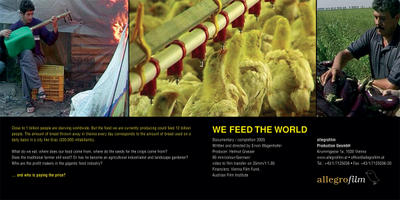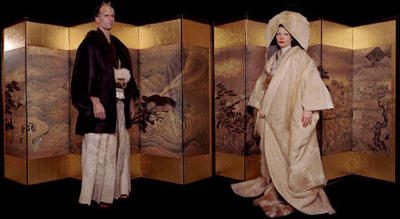
Had to wake up pretty early for this one; our first film of the day was up at the Isabel Bader theatre at the University of Toronto campus. I had been looking forward to this, and we arrived just in time. We found our seats and I wrote a bit... I knew that Francois Ozon was sort of inconsistant, but I was in for a bit of a shock.
Le Temps Qui Reste, while not nearly as awful, certainly challenged The Shore for most false, cliche ridden film of my festival this year. Throughout, Jenny thought I was trying to console her--it took her a bit to realize I was actually trying to apologize. My apologies as well to Francois Ozon, Charlotte Rampling and all involved with the much superior Sous Le Sable, from which this film was supposed to have progressed. The BFI Sight and Sound review of Sous Le Sable.

Jenny split for breakfast with Chris and Becky, and I was off to the thoughful, provoking documentary We Feed The World by Erwin Wagenhofer. We're given windows into a variety of food industry professions: the people who dispose of two-day old bread by the truckload in Vienna; a Brittany fisherman and fishmonger, both affected by the increasingly industrial minded EU; Austrian slaughterhouse workers lamenting the profit minded management; migrant workers and agronomists in greenhouse covered Almeria, Spain; hybrid seed manufacturersin Romania, Brazillian soy growers and climactically, the CEO of Nestle (the world's largest foodstuff provider), questioning the opinion that water is an inalienable right.
It's a broad, smart piece, showing conflict at every level: the private and industrial, rich and poor, veggies and meats. Most surprising though is that the dissent and disagreement comes from within each community--everyone concerned with a certain pervasive lack of care that seems to accompany progress and industrialization. The film seems to suggest that in the end, we are all complicit, no matter what we do, and that only our decision to change our own lives will have the power to affect others; we're all in this together--but sadly, none of us seem to care. An urgent, frightening picture of the real world; something everyone should see, and moreover, do something about.
and a summary from the TIFF program.
Of course this was followed by lunch, which was a much less pleasant affair, now having questioned the origin of everything ever made for consumption. Maybe the best solution is for everyone to have a little garden? At least a return to older, humbler practices where we honour the balance of giving and taking; hunting and gathering with a lot more responsibility. It's funny to think that perhaps the world has gone beyond its point of sustainable development--that now we probably need to step back. I don't know where animation and culture fit into all that. We gotta stop making excessive crappy stuff, I guess; culture should address some important things, I think.

And then I saw Matthew Barney's Drawing Restraint 9. Obviously part 9 of his Drawing Restraint series, it does bear resemblance and share concerns with his 5 part Cremaster Cycle. This is the place where contemporary art and contemporary cinema meet, and that makes it treacherous ground for me. Matthew Barney has been called "the most groundbreaking and celebrated American visual artist of the past decade", but is he a good filmmaker? Can his works be judged according to the same rules that I apply to conventional film, to everything else, really? Well, that's the only way that I know how to look at things, so that's the way I did; asking myself what someone was trying to do, whether or not they did it and whether it was worth doing. I'd try to describe the plot, but perhaps it's best for you to read a more official summary, courtesy of Bjork, one of the film's stars and composer of the soundtrack.
It is, ultimately, a love story, involving processes of construction and destruction, death and its imprints, and in classic Barney fashion, lots and lots of ritual: parades and pearl diving, dressing and tea ceremonies, whaling, construction and courtship involving ingestion. In perhaps the most striking sequence, Bjork and Matthew Barney, clad in all fur Kimonos in a half flooded room, draw knives to slowly and carefully slice each others legs apart; they pause, sensually regarding the flesh held in the others hand, which they in turn feed each other; a true communion of souls. But what does it all add up to in the end? Plenty and not too much, for me. A granola of symbols is what I come away with, but most of the time they're too allusory to involve me. I guess he expressed his thematic interests... but to what end? Was this poetry or clunky prose? I'm tending to think that I wouldn't find it worth doing myself; I guess this is one for the art critics to decide on. In association with the 21st Century Museum of Contemporary Art, Kanazawa.
It was dinner after this, a veggie platter at Saigon Sister, but all I could talk about was that food movie. It was dark now, and we set off to the Cumberland for our last film of the night and the last of the festival.

Wah-Wah, written and directed by Richard E. Grant, stars lots of great fellas and ladies including Gabriel Byrne, Miranda Richardson and Emily Watson. It depicts an early episode from Grant's own life, around the last days of colonialism in Swaziland. Young Ralph comes of age under tough circumstances of divorce, remarriage, alcoholism and britishness, and the film paints a picture intended to be bright and brassy, dark and a little violent, stuffy, funny, heartwarming and sad. The film did have a good deal of charm, in a british foreign film kind of way, but it processed some events too loudly and simply and awkwardly to get any real emotional grip on me. Many a time it resembled a stage play, and some of these episodes I enjoyed the most. Other times things played a little too cliche-ed, and the film had a rambling, directionless, repetitive quality to it that hurt its momentum coming into its third act. I think that perhaps films like this and The Shore which are based on real events need to veer away from the facts a little more to streamline and focus their direction. We did have a good time though, chatted with friendly strangers for a bit, put on sweaters and walked home; a very satisfactory end to a very satisfying festival.

What happened? You where inspired to draw, then suddenly it's all movie reviews. I am one to talk, my blog flops between two subjects too, but...
ReplyDeleteWell sir...
ReplyDeleteyeah, I know.
That was a whole lotta writing.
I had so many films to watch, I haven't had much time for drawing--and they sure don't let me draw at work.
Movies get me as excited as drawing does though, and the film fest is a pretty special opportunity to see premieres, talk to the directors and watch stuff you might never see again. There was a point where I figured that if I was going to cover this thing, I had to go all the way--anyway, it's my favourite time of the year.
I'm an aspiring story artist, so I try to get in as many as possible--and I think it's good to be able to express yourself critically.
That said, drawings are on the way...